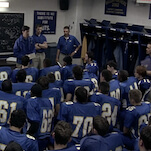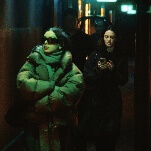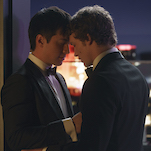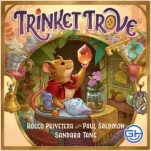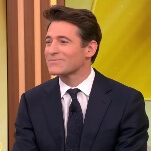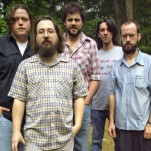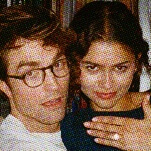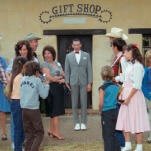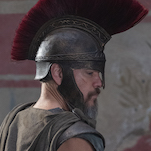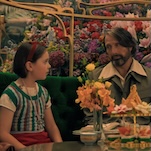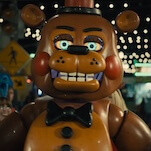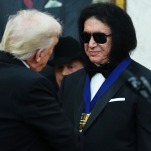“Honky Tonk Women” (season 1, episode 3; originally aired 11/06/1998)
“She doesn’t look it but she’s a real mean one, Faye Valentine.” –Punch-
We first meet Faye Valentine in an “herbal medicine shop.” The first shot of her is a close-up of her thighs, then the back of her head…then her ass. Then we see her from behind as she leans over the counter. Then she pulls her shades back and mouths hungrily, “Such pretty eyes,” as if she were speaking for us, the viewer. The dumbstruck shop owner can’t help but stare. The woman, with a cigarillo in her mouth and shades on, says as she loads a huge automatic weapon: “Ya know what’s the first rule in combat?” Seeing her targets outside the shop doors, she lets loose with a hail of bullets and stops only when her clip is empty. Spitting her cigarillo onto the floor, she answers her own question: “To get the first attack.” Then Faye gets outgunned in an instant and, with her hands in the air and a sheepish grin plastered on her face, she speaks for the audience for a second time: “What an extended greeting this is.”
“Honky Tonk Women” is indeed an auspicious and exciting introduction to Faye Valentine, who will later become the show’s main female protagonist. When we first meet Faye, Gordon, a casino boss, accuses her of being the “legendary female gambler,” Poker Alice. But, seeing that she does not look 220 years old, the age Alice would have to be by Gordon’s calculations, he dismisses that thought. He focuses again on the task at hand and latches onto Faye’s oversexed, femme fatale-like appearance. Faye’s body is her edge. Gordon drives that idea home by running his hand up her thigh, slowly, then suddenly pulling an Ace out of Faye’s bright yellow short-shorts. Faye defies expectations at every turn by being resourceful and more than just a pretty vamp.
From these first few scenes of Faye, “Honky Tonk Women” takes us to Spike and Jet as they enter a casino, intent on winning big. Yoko Kanno’s fantastic piano jazz piece starts playing after the elevators open and the two bounty hunters step out onto the casino floor. Kanno’s music sets the deliberate pace of this first casino sequence, reminding the viewer that Spike is immune to the fast-fast-fast pace of the casino. He saunters by the table where the three old men from the show’s first session are playing and scoops up some of their winnings, then walks lazily past an old samurai movie whose intertitles are translated in four different languages. Even Jet is winning big at a nearby one-armed bandit.
Spike’s leisurely pace is sustained until his first encounter with Faye. He stares dreamily at her, assured that he’ll win. Then she wips the smile off his face and beats him at Black Jack. His stare is petulant but quizzical. She’s upset him but he’s not angry, just anxious. He has to know: who is this woman and how did she win? Then we see a one-armed bandit hit the Bar three times in a row and an enigmatic smile form Faye. Again, Kanno’s music sets the pace for the following scene where we see Fay get her instructions from Gordon. The music compliments the scene of Faye and Gordon scheming in his office with a Morricone-esque piece for drums and harpsichord. A woman sighing lustfully also punctuates Kanno’s piece. It’s a perfect theme for Faye: who is she? An alluring mystery, one that plays up her sexuality as a weapon.
Spike’s smile returns to him when the casino’s hired muscle make their move. He’s beaming after he’s been punched in the face by one of the two heavies because he knows he can handle them. Here, he’s confident enough to ask, “What do you want?” rhetorically. He doesn’t need an answer because he’s already got one. With Faye, he can’t even bring himself to ask the question at first.
Spike doesn’t even seem to know what he’s doing beyond a point after he reveals that he was on to Faye’s scheme to clean him out of all of his earnings. He tells her he was “working with her” even when he clearly doesn’t know why she’s all het up about getting that one last chip from him. But at the same time, this encounter seems almost accidental. It’s not the meeting of two people that are deeply interested in each other: the sequence in Gordon’s office answered that question for us.
We come to understand later that Spike concluded that Faye is just like him—a “Romani” gypsy to his pride-less “Gorgio” wanderer, as Faye puts it later—based on what he observes at the casino table. But we don’t get to see that interaction. Instead, we see a flashback of Faye talking to Gordon about how she needs to make a stranger on a winning streak lose and then take a chip from him. The crucial scene where Faye’s mystique disappears at the Black Jack table is missing and in its place is the office-set flashback that only serves to further demystify her for us.
Which is an interesting conceit when you think about it. For the moment, Spike is still our primary eyes and ears into Cowboy Bebop’s world. He doesn’t need to remain intrigued by Faye because the information that his meaningful stare sought out is given to us in the form of the aforementioned flashback. We get what Spike wants in that preliminary moment at the Black Jack table.
And after that moment passes, Spike regains his cool and goes back to waiting for information to just fall into his lap. Faye’s mystery as a femme fatale is (mostly) solved. For the rest of the episode, she’s not taken as seriously, almost akin to comic relief, like when Ein chases her around the ship or, when Faye’s handcuffed and is begging to be released and Jet comments bemusedly, “Man, we got one yappy woman here.”
(Spoiler) At least, she is until she shows up at the end of the magnetic strip showdown (which is incidentally one of my favorite sequences in all of the show) in her space ship and winks at Spike: “Hi, ‘Gorgio.’” When this scene ends, Faye becomes a sexualized threat again, blasting off for parts unknown with money that’s not hers. It’s no coincidence that Spike mutters, “You wench…” to himself as she flies off at the end. The scene at the casino later is perfunctory: she’s gone and Spike effectively helped her to get away. But when she’s actually gone, he confesses, to nobody in particular, that he still doesn’t get her (Who but a deeply confused person would curse “You wench…” at somebody?). That kind of nuanced interplay between Spike and Faye is one of the many reasons why “Honky Tonk Women” is one of my favorite Bebop sessions. Here’s hoping it treats you as well, space cowboys.








